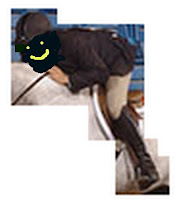For every discipline and every breed, there is an organization who sets the standard for the purpose of judging. Most western classes follow the AQHA (American Quarter Horse Associations) rules and stock breed registeries follow suit. For hunters, it's the USEF (US Equestrian Federation formerly American Horse Show Association or AHSA & they had a couple years calling themselves the USEA aka US Equestrian Association) that sets the standards. For reining there is the NRHA (National Reining Horse Association) and dressage has the USDF (US Dressage Federation). There are many other disciplines that are subjectively judged but we'll stick to the basics of open show classes being hunters and western non timed events.
For the purpose of judging, we have the standards set for hunters by going to the origins of show hunters. A show hunter is the condensed version of the optimum fox hunter. A horse that exerts minimum energy to execute a ground covering stride at all gaits and has impeccable manners thereby freeing up the rider's mind for the strategy of following the hunt.
As a standard rule, a horse that has high knee action, does not cover much ground in his rather vertical gait. The leg does not swing freely from the shoulder and this is heavily penalized. A horse that is inverted in his topline is not using his hind quarters to propel forward and thereby also inhibiting a forward moving, ground covering stride. Again, heavily penalized. A horse that twitches and flinches at garbage barrels and outside distractions has not the experience to calmly negotiate a course of even more unfamiliar obstacles. A horse that does not travel well in company, is definitely not a good example of a mannerly mount.
Unfortunately these types of horses are not always common at an open show. Breeding is not always selective and people end up with all shapes and sizes of horses that may well go the distance but not be optimum for the show ring. Should these riders even bother? Of course! Your horse may not fit the exact standards or even come close to an efficiently built hunter but consider that the other horses who show up on that day at that show, may not either.
You need to know how your horse measures up to the standards set forth for the hunter ring and go from there. Knowing major & minor faults from the USEF rules is also something everyone who shows hunters, whether a backyard type show or rated USEF show, should know. Sadly, reading the standards for hunters, rules and faults, is not emphasized by trainers and coaches or saddder still, some judges. There are plenty of riders that have never cracked a rulebook and it shows.
In today's society of 'get'er done attitudes, many organiztions have pushed the boundaries of when a horse should peak in performance. By that, I'm referring to the 2 year old and 3 year old classes, divisions and futurities of several breed organizations and even national awards. If you are jumping a horse that is less than 5 over fences in excess of 2' 6" (and I'm being generous with that height), how can you expect this horse to hold up in the long run. Maybe he looks gorgeous and has the mindset of a saint but he is not done growing. The high impact placed on his muscular, skeletal and neurological systems will most likely show symptoms of break down by the time he is 12 or so. So you're planning on selling him by then and if he achieves this award for the youngest of hunters, he'll bring extra zeroes along on that check from the buyer. He won't be your problem when he breaks down and by then you'll be long gone. This is just my opinion of course and only one short synopsis of yet another crappy standard being set up by big money to further push the imitation hunter out of the nest way too early. I say imitation because I cannot imagine seeing many (any) 2 year olds showing hunter on the flat (or under saddle as some organizations refer to it) correctly.
Then of course there are the monkey see, monkey do crowds that worry more about getting a horse' head to his knees, than engaging his hocks. Take western pleasure for example. Artificial doesn't begin to make a dent in todays models of western pleasure. There is nothing western nor pleasurable about it. READ THE RULES!! The standard for western pleasure is set forth by the AQHA and most breed groups and open shows, follow these rules.
A pleasurable western mount should have stride, in keeping with his conformation, that covers ground easily with minimal effort. A free flowing gait that is relaxed. The western pleasure horse should have a relaxed topline, keeping his poll fairly even with the withers; slightly above depending on conformation and never below. He should carry the bit willingly either on the vertical or slightly forward but never behind. He should possess the manners of a saint. When was the last time I saw this? Hmmmmm, it's been a while.
People get so over the top trying to get their horse to 'keep his head low' they miss the whole point. The horse gets stiff. The gaits become impure (4 beating lopes and 2 foot strides at the jog). The relaxation is so lost that some horses I see have created ways to please their riders, but become convaluted in their mindsets.
The standards that are not adhered to in training a horse for either western non timed events or show hunters can become so lost that the horse moves with the utmost artificial and imitation means. So what has all my rambling about standards accomplished here? Well, for one, you need to know how your horse measures up to the standards set forth for subjective judging.
So as a judge, you must know the standards. The baseline by which a horse is judged for a certain discipline whether open or breed specific. Then, as you watch the class at hand, you must incorporate the weight of a fault, also set forth by the rules of the guideline association. On top of that, you now have to decide if this horse is closer to that baseline than the others in the class. It takes alot of reading, practice and keeping up with the changes to be a judge. I do not think it is for everyone and I also think there are a few out there that could use a good updating seminar but that's coming in another post later on.
My point is that you should read the rules. Assess your horse by the standards of the discipline and/or breed. Know what the major faults are that you can fix by riding better or gaining more knowledge. Recognize that just because old Dobbin is fearless over fences, maybe he doesn't have the flat kneed, free flowing gaits to win the hack. Improve on his strong points. Get your points over fences, ride the flat the best you can and if the tri colors are to come your way, they will because old Dobbin nailed those courses.
If you are showing in western non timed events, i.e. pleasure, horsemanship, trail, etc.... read the rules. Know what is wrong and even if the one who keeps winning top call has the movement of a foreign robot from distant lands, rest assured you will come across a judge that knows their stuff. That robot will not live long and proper.
For whatever your opinion is on subjective judging, there are a thousand arguments for and against it. My advice here is to
Read the rules
Know the major faults
Don't compromise your horse' happiness and well being for the quickie award or because everyone else is doing it. There are plenty of shows, awards and programs to enhance your collection. Try a different circuit, association or discipline. You'll find your niche and keep your horse on his feet for more years than you can count on both hands and feet. If in fact you want an award or recognition, just because, then buy yourself a trophy online. There's Trophy Depot, Crown Trophy, Winning Ways East, Hodges Badges, and those are just a few that I read on the bottom or back of awards laying around the desk and mantle.
The show is not the means to an end but rather a rest stop on the journey.







